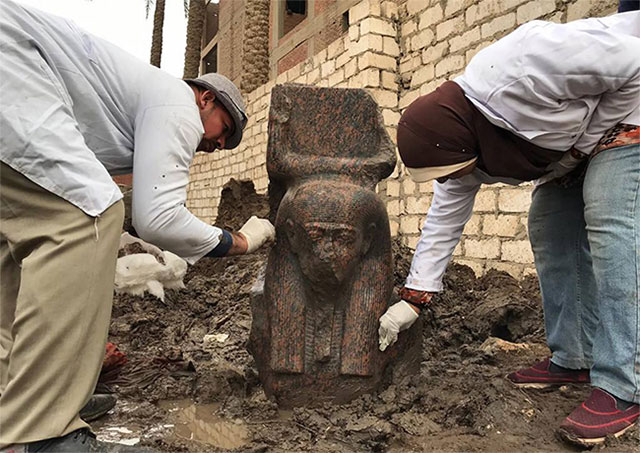Rare bust discovered by ancient Egyptians
The Ministry of Antiquities on 11/12 announced the discovery of a bust of pharaoh Ramesses II of the 19th Dynasty in Egyptian history.

Bust of pharaoh Ramses II was excavated in Egypt.(Photo: AP).
The 105cm tall and 55cm wide statue was found on private land in the Mit Rahina region, near the ancient city of Memphis, about 30km south of Cairo. This is the first pink granite bust ever excavated by pharaoh Ramses II.
The Egyptian Ministry of Antiquities emphasized this was a rare discovery because the artifact contained the symbol "ka", representing the soul of a person or god who could reside in the statue after his death.
Ramses II was hailed as one of the greatest and most powerful kings in ancient Egyptian history. He was the third pharaoh of the 19th Dynasty, to rule the country between 1301 and 1236 BC. The intact preserved mummy of Ramesses II was found in 1881 and is now on display at the Egyptian Museum in Cairo.
Egypt has in recent years relentlessly promoted archaeological discoveries across the country, in an effort to revive the tourism industry that was severely affected by the wave of protests and violence in 2011.
- Pharaoh Ramsses II statue was discovered in Egypt
- Egypt discovered an ancient tomb from the time of Pharaoh Ramses II
- 6 things we do not know about the people of ancient Egypt
- Revealing the
- Ancient Egyptians love to eat pork
- Discovered the 3400-year-old temple of the ancient Egyptians
- How to transport stone to build pyramids of ancient Egypt
- Ancient Egyptians made jewelry from meteorites
- Discover typical dishes of ancient Egypt
- Why do ancient Egyptians only sex in the summer?
- Ancient Egyptians were good seafarers
- Discovered an ancient tomb over 3,500 years old in Egypt
- Raw materials for blue ink production of ancient Egypt
- Why did the ancient Egyptians worship lotus images?
 Discovered an ancient centipede fossil 99 million years old
Discovered an ancient centipede fossil 99 million years old Discovered bat-like dinosaurs in China
Discovered bat-like dinosaurs in China Discovered a 200-year-old bronze cannon of the coast
Discovered a 200-year-old bronze cannon of the coast Discover 305 million-year-old spider fossils
Discover 305 million-year-old spider fossils